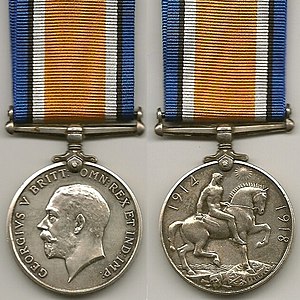British War Medal
| British War Medal | |
|---|---|
 |
|
| Awarded by the Monarch of the United Kingdom and the British Dominions, and Emperor of India | |
| Country |
|
| Type | Campaign medal |
| Eligibility | British and Imperial forces |
| Awarded for | Campaign service |
| Campaign(s) | First World War |
| Statistics | |
| Established | 26 July 1919 |
| Total awarded | 6,500,000 silver 110,000 bronze |
| Order of wear | |
| Next (higher) | 1914–15 Star |
| Next (lower) |
Victory Medal (United Kingdom) Victory Medal (South Africa) |
|
Ribbon bar |
|
The British War Medal is a campaign medal of the United Kingdom which was awarded to officers and men of British and Imperial forces for service in the First World War. Two versions of the medal were produced. About 6.5 million were struck in silver and 110,000 were struck in bronze, the latter for award to Chinese, Maltese and Indian Labour Corps.
The British War Medal was instituted on 26 July 1919 for award to those who had rendered service between 5 August 1914, the day following the British declaration of war against the German Empire, and the armistice of 11 November 1918, both dates inclusive. Consideration was given to the award of clasps to commemorate certain battles and theatres of operations and some 68 clasps were proposed for Naval recipients and 79 for the Army. While the Naval clasps were authorised in August 1920, none were awarded and the idea was abandoned in 1923.
Unlike the 1914 Star and the 1914–15 Star, the British War Medal could be awarded to all officers and men of British and Imperial forces who had served for a prescribed period during any stage of the war, or who had died on active service before the completion of this period. Eligibility for the award of the medal was subsequently extended to cover service in 1919 and 1920 in mine-clearing at sea as well as participation in operations in North and South Russia, the eastern Baltic region, Siberia, the Black Sea and the Caspian Sea.
For the Royal Navy, Royal Marines and the Dominion and Colonial naval forces, the criteria were 28 days mobilised service, but without a requirement for overseas service. The medal was presented to the next-of-kin of all casualties, including those who were killed before the completion of this 28 days period. The medal was also awarded, with the same criteria, to members of the Women's Royal Naval Service, to members of Queen Alexandra's Royal Naval Nursing Service and Royal Naval Nursing Service Reserve, and to a number of non-Naval personnel who served on Royal Navy ships, such as canteen and medical staff.
...
Wikipedia
